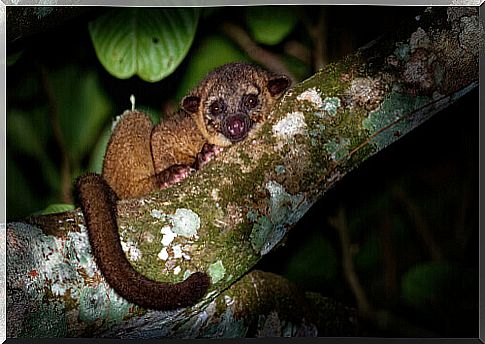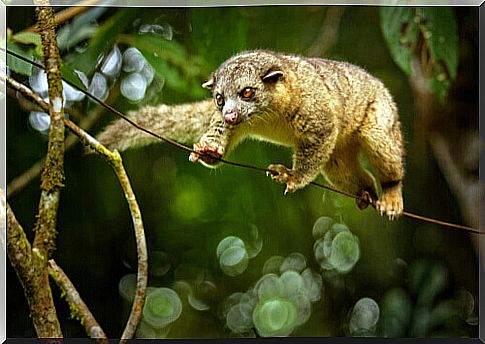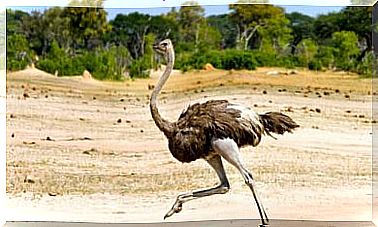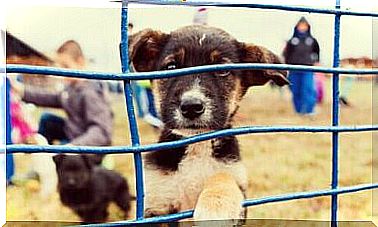Juparás: Behavior And Habitat

Juparás are small climbing mammals with nocturnal habits. In nature, they spend most of their time in treetops.
Although they look somewhat like apes, in fact, yuparas are more closely related to raccoons, coatis and red pandas.
The jupará can gather fruit and honey using its long tongue while climbing trees. That’s how he got the nickname Honey Bear. In addition, it is also known by several other names: gatiara, night monkey, gogó-de-sola, janaú, planter monkey. And its scientific name is Potos flavus .
General features
This animal is an unusual member of the raccoon family, being the only species in the genus Potos . The jupará is distinguished by its long, prehensile tail, short snout and low, rounded ears.
The animal uses the prehensile tail as a ‘fifth hand’ during the climb. However, he doesn’t use it to get the food. One quirk is that as he moves, his spine can rotate 180 degrees from hip to neck.
Although the jupará is related to the raccoon, its appearance, behavior and ecology are more similar to a primate. In fact, the jupara was originally described to the scientific community as a lemur.
They have soft, gray or golden brown fur, large eyes and a small, rounded face. Their eyes are very reflective of light, looking like a bright orange eye shadow. These animals can turn their feet backwards, thus making the task of climbing trees easier.
The size of the jellyfish varies a little between the subspecies, but, in general, its body length is less than 61 centimeters, excluding the tail, which is between 40 and 57 centimeters. In general, adult weight ranges from 2 to 3.2 kilos.

Habitat and habits of the juparás
The jupará is an agile inhabitant of the upper canopy of tropical forests and can be found throughout Central and South America.
Currently, wild populations of this species are in decline. This is due to the fact that they only have one calf a year, along with the destruction of their natural habitat and the illegal trade in exotic animals.
This mammal has nocturnal and arboreal habits. It is usually most active between 7:00 pm and 12:00 am, and again an hour before sunrise. During the day, yuparas sleep in holes in trees or under the shade of leaves to avoid direct sunlight.
It is common for them to form stable groups in which members, mainly males, practice social grooming. After a night of adventure, the group goes each morning to certain holes in the trees to sleep together.
The juparás vocalize a lot. They have a repertoire of vocalizations that include soft sighs, chirps or whistles or even a ‘barking’ noise, like a dog screaming. They also produce a high-pitched wheeze that can be very loud (a call to food) and others described as ‘sneezing’.
They rarely come out of the treetops. They feed mainly on fruits and insects, and also drink the nectar of flowers during periods of drought. A litter consists of one or two puppies, born in spring or summer.
Jupara domestication
The jupara generally shows little fear of humans. In general, juparás tend to bond with one or two humans. Although it is offered for adoption as a pet, living with it presents several obstacles.
The animal cannot be trained to control its needs. They make a mess and like to throw food and objects. The jupara has anal glands that produce a musky odor when the animal is angry or scared.
Although considered docile when acquired young, the jupara can react by scratching or biting. In captivity, they can live for 20 years or more.

Sometimes they can be aggressive. The jupará does not like sudden movements, noise and staying awake during the day. It has also been shown that it can transmit a number of diseases. Thus, in addition to the risk to human health, owning a jupara is also harmful to the animal.
Replicate your rainforest environment can be quite difficult. Raising it in an environment other than the rainforest can increase the risk of disease and ruin your quality of life.
What does the jupará eat?
Juparás feed mainly on fruits and nectar or honey in nature. However, when the opportunity arises, they sometimes eat insects, eggs and frogs, along with other plants and flowers.
Because of the type of food they consume, they are considered important seed dispersers and are even considered to pollinate some plant species.
In captivity, they can be fed monkey crackers and a variety of fruits. Among these tropical fruits are bananas, papaya, mango, melon, kiwi fruit, grapes, pineapple, pomegranate and fig.
Water can be supplied in a container, but it is likely to spill or get dirty. For this reason, a heavy water bottle with a suction tube usually works best.
In El Salvador, Guatemala and Honduras, the juparás are commonly called micoleón , which means ‘lion monkey’. In Peru, the juparás are commonly known as lirón (‘ dormouse’ , a rodent mammal that looks like a mouse) or mono oso (‘bear monkey’).

jupara conservation
Its natural predators are birds of prey (eagles and falcons), the jaguar, the puma and other smaller cats. However, humans are still by far its biggest predator.
Some ethnic groups in Central and South America are hunted for food, but the main purpose of hunting is their skin. In addition, puppies are sold as pets through illegal trafficking.
This species is on CITES Appendix III for Honduras. In Mexico, it is considered a fragile species, but little is known about the status of its populations.









